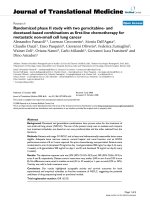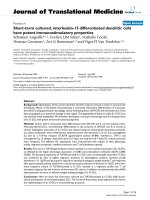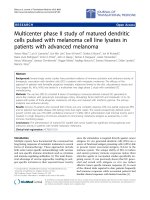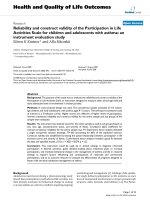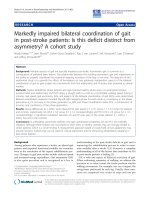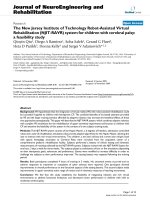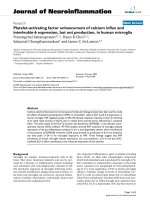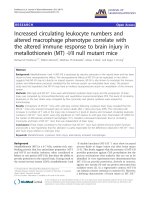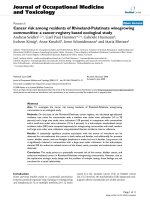Báo cáo hóa học: "Multicenter phase II study of matured dendritic cells pulsed with melanoma cell line lysates in patients with advanced melanoma" potx
Bạn đang xem bản rút gọn của tài liệu. Xem và tải ngay bản đầy đủ của tài liệu tại đây (7.54 MB, 11 trang )
RESEARC H Open Access
Multicenter phase II study of matured dendritic
cells pulsed with melanoma cell line lysates in
patients with advanced melanoma
Antoni Ribas
1*
, Luis H Camacho
2
, Sun Min Lee
3
, Evan M Hersh
4
, Charles K Brown
5
, Jon M Richards
6
,
Maria Jovie Rodriguez
2
, Victor G Prieto
2
, John A Glaspy
1
, Denise K Oseguera
1
, Jackie Hernandez
1
,
Arturo Villanueva
1
, Bartosz Chmielowski
1
, Peggie Mitsky
3
, Nadège Bercovici
3
, Ernesto Wasserman
7
, Didier Landais
3
,
Merrick I Ross
2*
Abstract
Background: Several single center studies have provided evidence of immune activation and antitumor activity of
therapeutic vaccination with dendritic cells (DC) in patients with metastatic melanoma. The efficacy of this
approach in patients with favorable prognosis metastatic melanoma limited to the skin, subcutaneous tissues and
lung (stages IIIc, M1a, M1b) was tested in a multicenter two stage phase 2 study with centralized DC
manufacturing.
Methods: The vaccine (IDD-3) consisted 8 doses of autologous monocyte-derived matured DC generated in
serum-free medium with granulocyte macrophage colony stimulating factor (GM-CSF) and interleukin-13 (IL-13),
pulsed with lysates of three allogeneic melanoma cell lines, and matured with interferon gamma. The primary
endpoint was antitumor activity.
Results: Among 33 patients who received IDD-3 there was one complete response (CR), two partial responses (PR),
and six patients had stable disease (SD) lasting more than eight weeks. The overall prospectively defined tumor
growth control rate was 27% (90% confidence interval of 13-46%). IDD-3 administration had minimal toxicity and it
resulted in a high frequency of immune activation to immunizing melanoma antigens as assessed by in vitro
immune monitoring assays.
Conclusions: The administration of matured DC loaded with tumor lysates has significant immunogenicity and
antitumor activity in patients with limited metastatic melanoma.
Clinical trial registration: NCT00107159.
Introduction
Multiple reports have documented the occasional but
long lasting responses of metastatic melanoma to several
forms of immunotherapy. These approaches include
both active tumor-specific immunotherapy with vaccines
and non-specific immune stimulants suc h as cytokines
and immune-regulating antibodies [1]. The main theore-
tical advantage of vaccine approaches resulting in anti-
gen-specific activation is their expected lower toxicity
since the stimulation is targeted directly against cancer
antigens. Ex vivo generated dendritic cells (DCs) are a
source of functional antigen presenting cells (APCs) able
to present tumor associated antigens (TAAs) to the
immune system. The unique ability of DCs to induce
and sustain primary immune responses makes them
attractive agents in vaccination studies specifically tar-
geting cancer. It was previously shown that DC gener-
ated and armed with antigens ex vivo can induce
effective tumor specific immune responses [2]. In most
of the cli nical trials reported to date, patients frequently
had immune responses while occasional patients had
durable clinical responses with limited toxicities [1].
* Correspondence: ;
1
University of California Los Angeles (UCLA), CA, USA
2
MD Anderson Cancer Center, Houston, TX, USA
Full list of author information is available at the end of the article
Ribas et al. Journal of Translational Medicine 2010, 8:89
/>© 2010 Ribas et al; licensee BioMed Central Ltd. This is an Open Access article distributed under the terms of the Creative Commons
Attribution License ( g/licenses/by/2.0), which permits unrestricted use, distributio n, and reproduction in
any medium, provided the original work is properly cited.
IDD-3 is a cellular therapeutic vaccine consisting of
autologous monocyte-derived matured DC, generated
from a single apheresis of peripheral blood mononuclear
cells (PBMC), cultured in serum-free medium in the
presence of the cytokines granulocyte macrophage col-
ony stimulating factor (GM-CSF) and interleukin-13
(IL-13) and pulsed with tumor lysates produced from
threeallogeneicmelanomacelllines[3,4].Thesecell
lines were selected bec ause they e xpress proteins that
have been identified as common melanoma antigens
and t hey are known to trigger CD8 cytotoxic responses
in vivo [5,6]. An initial phase I/II study was performed
pulsing IDD-3 with just one melanoma cell line lysate
(M17) together with hepatitis B surface protein and teta-
nus toxoid [3]. This pilot study demonstrated the immu-
nogenicity of this vaccine approach and provided early
evidence of antitumor activity. One patient with in-tran-
sit metastasis had a durable complete response out of
15 patients. A follow up phase I/II st udy was performe d
with IDD-3 formulated by pulsing with 3 melanoma cell
lines (M44, SKMel28, Colo829), with or without matura-
tion with a bacterial membrane fragment of Klebsiella
pneumoniae known as FMKp and interferon gamma
(IFN-g) [4]. Twenty-six patients received immature IDD-
3 and 23 received mature IDD3. Of the 40 patients eligi-
ble for evaluation, 14 sho wed an immune response
aga inst TAAs (Melan-A/MART1, NY-ESO-1, tyro sinase
or gp100), with no differences between samples from
patients who received immature or matured IDD3.
There were no objective tumor responses in this popula-
tion of patients with more advanced metastatic
melanoma.
The present study was undertaken to investigate the
antitumor activity of IDD-3 in patients with metastatic
melanoma limited to the skin (includin g in-transit), sub-
cutaneous tissues, lymph nodes or the lung. As sug-
gested by the initial clinical trial with IDD-3 [3],
restricting inclusion to patients with limited metastatic
disease allows a more adequate patient selection for the
testing of this therapeutic vaccine. In this targeted popu-
lation IDD-3 induced both immune stimulation and had
anti-tumor effects.
Patients and Methods
Study Design and Conduct
This was a single-arm, two stage, open-label, multi-cen-
ter phase II study. In the first stage, 12 patients were
enrolled, and since a minimum threshold for clinical
activity was met, enrollment proceeded to a s econd
stage with up to 38 total patients. A written informed
consent, previously approved by the Institutional Review
Board at each study site, was obtained from each
patient. The study was conducted in accordance with
local regulations, the guidelines for Good Clinical
Practice (GCP), and the principles of the current version
of the Declaration of Helsinki. The study opened to
accrual at five US centers and was sponsored by IDM
Pharma Inc (Irvine, CA).
Study Objectives
The primary objective was to assess the clinical activity
(as measured by tumor control) following IDD-3 vaccine
administration to patients with limited metastatic mela-
noma. Secondary objectives included the evaluation of
immunologic activity of IDD-3 as measured by T-cell
responses to melanoma antigens, and to assess the safety
of the treatment as measured by the incidence and
severity of adverse events.
Study Population
Patients older than 18 yea rs old with a histologically
confirmed primary cutaneous melanoma or melanoma
of unknown primary site were eligible. Stage eligibility
included non-resected in-transit (Stage IIIb-N2C or
stage IIIC-N3), or distant skin, subcutaneous or lymph
node (Stage IV-M1a), or pulmonary (Stage IV-M1b)
metastases, with serum lactate dehydrogenase (LDH)
below 1.5× the institutional upper limit of normal. At
least one me asurable or evaluable lesion (e.g. small
volume cutaneous lesions) was required. There was no
restriction on th e number of prior therapies, except that
patients who had received prior vaccine therapy w ith
one or more melanoma antigens or peptides were
excluded. History of autoimmune disease (other than
vitiligo), immunodeficiency syndromes (including HIV
positive testing), or requirement for chronic systemic
immunosuppressive treatment were also excluded.
IDD-3 Preparation and Administration
A baseline leukapheresis was performed using the COBE
Spectra apheresis system (Gambro BCT, Lakewood, CO)
according to established procedures for peripheral blood
mononuclear cell (PBMC) c ollection. If needed, up to
three leukaphereses could be planned to obtain a target
goalof2×10
9
PBMC. Within 24 hours of t he apher-
esis, the product was transferred at ambient temperature
to the IDM manufacturing facility in Irvine, CA, where
DC cells were manufactured in GM-CSF (700 U/mL,
Sargramostin, Berlex) and IL-13 (136 ng/mL, Sanofi-
Aventis, Labege, France) as previously described [3,4,7].
After a 7 day culture, purified DC were pulsed overnight
with 3 melanoma cell line lysates derived from M44
(from F. Jo tereau, Nantes, France), COLO829 and SK-
MEL28 (both from American Type Culture Collection
-ATCC-, Rockville, MD). The Master cell banks and
tumor-cell lysates were manufactured and lot release
tested by BioReliance Corporation (Rockville, MD). Den-
dritic cells were then incubated for 6 hours with F MKp
Ribas et al. Journal of Translational Medicine 2010, 8:89
/>Page 2 of 11
(1 μg/mL, Pierre Fabre, St Julien en Genovois, France)
and IFN-g (500 U/mL, Boehringer Ingelheim, Vienne,
Austria) to mature the DC. A single IDD-3 dose was
made of a sterile suspension of matured and pulsed DC
at a concentration of 25 × 10
6
cells per mL, cryopre-
served in 1 mL of sterile saline with 10% DMSO and 5%
human serum albumin. The cell product was stored in
labeled vials and cryopreserved in liquid nitrogen. The
cryopreserved product was transfer red to the clinical site
with continuous temperature monit oring. The vaccine
was administ ered within one hour of thawing and recon-
stituting in 3 mL of sterile saline. Patients were scheduled
to receive six IDD-3 immunizations at two-week intervals
during the first 10 weeks of treatment, and additional two
immunizations at six-week intervals. Each dose of 25 ×
10
6
cells was administered by injection close to two unin-
volved lymph node-bearing regions. For each region, five
i.d. injections of 0.1 mL and one s.c. injection of 1.0 mL
were performed, giving a total o f 3.0 mL per dose.
Patients who were felt to have clinical benefit were eligi-
ble to continue receiving IDD-3 every e ight weeks until
all available doses had been administered or the patient
experienced disease progression.
Study Assessments
To evaluate the primary objective of clinical activity, dis-
ease assessment was performed at baseline and in weeks
8 and 12. Tumor growth contro l was expressed as the
proportion of patients with a CR or PR maintained for
at least four weeks, or SD lasting at least eight weeks,
following the Response Evaluation Criteria in Solid
Tumors (RECIST) [8]. Lesions in the skin and subcuta-
neous tissues, evaluable only by physical examination
and not detected using imaging studies, were considered
measurable if adequatel y recorded using a camera with
a measuring tape or ruler. To evaluate the secondary
endpoint of immune responses, blood samples were col-
lected at baseline, prior to the first IDD-3 administration
and at various time points thereafter. Cellular immune
responses (IFN-g secretion) to melanoma lysates
included in the vaccine, as well as to peptides derived
from TAAs, were assessed by ELISPOT assay as pre-
viously described [4]. Safety evaluation was also a sec-
ondary endpoint, with toxicities evaluated with
particular attention paid t o injection site reactions
(erythema, induration, tenderness, pain, lymph node
enlargement), ocular toxicity, f ever, autoimmune reac-
tions and vitiligo. All adverse events were graded and
documented according to standard criteria (NCI-
CTCAE v3.0).
Sample Procurement and Processing
Blood samples for immune monitoring were collected
before vaccination (referred to as w0 sample), during
treatment (w4, w8, w12), and during follow-up pe riod
(w24 and w48). PBMC were collected through a partial
apheresis at baseline and in study week 12, and blood
samples were drawn in study weeks 4, 8, 24 and 48.
Samples were shipped to the IDM central laboratory
(Irvine, CA), where PBMC were obtained after separa-
tion over Ficoll gradient centrifugation. Cells were
cryopreserved in fetal bovine serum (FBS) containing
10% DMSO, and stored in liquid nitrogen. Before
cryopreservation, PBMC suspensions were analyzed for
viability, white blood cell content (CD45
+
), and resi-
dual presence of granulocytes (CD66b) by flow
cytometry.
In Vitro Sensitization
Cryopreserved PBMC samples were thawed, resus-
pended in AIM V medium completed with 5% human
AB serum and 25 mM HEPES (compete Aim V med-
ium), and incubated for 5 minutes at 37°C with 5 U/mL
DNase I. Washed cells were incubated overnight. Poten-
tial clumps were further eliminated the next day by an
optional additional DNase I treatment. PBMC were sen-
sitized to peptide pools in vitro during a 14-day culture
period. Depending on the number of cells available, 3 to
12 × 10
6
viable PBMC were seeded in micro culture
plates (2 × 10
5
PBMC per well) in complete AIM V
medium, with an equivalent number of wells between
time points for each pool of peptides. PBMC were sti-
mulated independently with up to 4 pools of peptides
derived from single antigen families and restricted by
the applicable HLA molecules (Additional file 1, Table
S1), with each peptide present in culture at a final con-
centration of 1 ug/mL. T he peptide pools represented
the following 4 groups of melan oma tumor antigens:
i) gp100 family, ii) tyro sinase and TRP-2 fam ily,
iii) MAGE family, and iv) additional miscellaneous
tumor antigens AIM-2, Melan-A/MART-1, NY-ESO-1,
PRAME, TAG, FGF5, UK , OA1, GPC3, WT1, RNF43,
RAGE, and MUM-2 (a detailed list of peptide pools
composition is shown in the Additional file 1, Table S1).
In addition, a positive control peptide pool made of
HLA class I peptides from C Cytomegalovirus, Epstein-
Barr Virus, and Flu Virus (CEF peptides, Cellular
TechnologyLtd.,ShakerHeights,OH),andanegative
control pool of HIV-derived peptides that cover HLA
class I-restricted T cell e pitopes were used for the in
vitro sensitization procedure. Cytokines promoting the
expansion of activated T-cells were added to the wells
on days 1, 6, and 10 or 11 of the 14 day in vitro sensiti-
zation culture period. Interleukin (IL)-7 and IL-15 were
added at a final concentration of 5 ng/mL and 1 ng/mL,
respectively. On days 6 and 10 or 11, the cytokine addi-
tion was accompanied by a renewal of half of the culture
medium.
Ribas et al. Journal of Translational Medicine 2010, 8:89
/>Page 3 of 11
Detection of IFN-g and CD107a/CD107b by
Flow Cytometry
Detection of T-cells specific for tumor antigen epitopes
was performed after IVS or directly ex-vivo after thawing
PBMC samples. Activation of spec ific T-cells was moni-
tored by production of IFN-g and exposure to the cell
membrane of lysosome-resident CD107a and CD107b
proteins in the presence of peptides. Briefly, 10
6
cells
were incubated for 5 hours with 10 μg/mL of TAA pep-
tides used during the IVS (test sample), an irrelevant
HIV peptide pool (negative control), or 25 ng/mL of
phorbol 12-myristate 13-acetate (PMA) and 5 μg/mL
ionomycin (positive control). Cells sensitized with the
viral CEF pool were incubated with the negative control
HIV pool, 2 μg/mL of the positive control CEF peptide
pool, or PMA/ionomycin as non-specific positive con-
trol. The incubation was performed in the presence of
anti-CD107a and anti-CD107b antibodies. Brefeldin A
(10 μg/mL) and Golgi stop (monensin, 6 μg/mL) were
added 1 hour after peptide stimulation. Cells were t hen
stained with anti-CD8-PE and anti-CD3-PerCP antibo-
dies, fixed and permeabilized with the Intrastain kit, and
stained for intracellular IFN-a with an anti-IFN-g-APC
antibody. Cells were resuspended and stored for up to 4
days in PBS 1% Cytofix before being analyzed on a
FACSCalibur flow cytometer. Anti-TAA specific CD8
+
cells were defined as cells producing IFN-g (with or
without CD107 expression) after stimulation with TAA-
peptide pools. The CD8
+
T cell population was defined
by gating on lymphocytes according to size and struc-
ture (FSC/SSC ), follow ed by gating on CD8
+
CD3
+
lym-
phocytes. An average of 80,000 ± 40,000 CD8
+
events
were collected from each sample. Data shown in this
report are expressed as the proport ion of net TAA-spe-
cific CD8
+
events for 10
5
total CD8
+
cells.
Detection of Melan A-specific T Cells with MHC tetramers
When sufficient cells from HLA-A*0201 positive sub-
ject s were available, T cells (10
6
cell s) were stained with
Melan A/MART-1 tetramers or neg-tetramers as control
(all from Beckman Coulter), and with anti-CD8-FITC
(BD Pharmingen) as recommended by the manufac-
turers. After washing, cells were stained with TOPRO3
(Molecular probe) to exclude dead cells and were ana-
lyzed by flow cytometry.
Sample Size Determination and Statistical Analysis
The clinical trial followed a Simon two-stage optimal
design [9] with an assumed tumor growth cont rol
(objective responses by RECIST plus SD beyond 8
weeks)rateof20%,anullresponserateof5%,atype
one error of 0. 10, and a type two error of 0.10. As such,
continuation to the second stage required one patient
outofthefirst12recruitedtodemonstratepositive
tumor growth control during the first 12 weeks of treat-
ment. After completing the second stage, if four or
more out of 37 patients were observed with tumor
growth control the trial was deemed positive. The prob-
ability of early termination due to an unacceptably low
response (i.e., the null responserateistrue)was54%.
Assessment of the secondary objective of immunological
activity was determined by determ ining the proportio n
of patients showin g an induction or increase in immune
response to melanoma lysates or TAAs following treat-
ment. Patients evaluable for immune response were
those eligible patients who had received at least two
doses of IDD-3 vaccines, had a valid baseline immune
response assessment and provided at least one post-vac-
cination blood sample. A patient was considered to have
a positive immune response to treatment if there was a
two-fold or greater increase in the lysate- or peptide-
specific T-cell responses or antibody titer at any post-
vaccination time point compared to the pre-vaccination
sample. For each IVS condition (for example, stimula-
tion with peptide pool 1), the numb er of IFN-g positive
events (and negative events) on CD8
+
CD3
+
lympho-
cyt es were analyzed for stimulations with HIV peptides,
TAA peptides o r PMA/ionomycin. A test sample was
considered positive and T cells specific for a peptide
pool we re considered detectable if the following condi-
tions were met. First, the positive control (PMA/iono-
mycin) displayed a significantly higher number of IFN-g
positive CD8
+
CD3
+
cells than the negative control HIV
pool by the Chi-square test, provided that the Chi
square test was a pplicable between test sample and
negative control samples since the number of events
was sufficient. Second, the test sample displayed a signif-
icantly higher number of IFN-g positive CD8
+
CD3
+
cells than the negative control by the Chi-square test,
provided that the number of IFN-g positi ve CD8
+
CD3
+
cells in the test sample was at least twice that in the
negative control and the difference of these two num-
bers was at least 0.1% of the total CD8
+
CD3
+
population.
Results
Study Patients
Bet wee n February, 2005 and August, 2006, a total of 45
patients were assessed for study entry. Seven patients
did not meet the eligibility criteria after screening tests.
Patients were recruited from five centers in the U SA;
the majority of recruitment (82% of patients) occurred
just at two centers. The demographic characteristics of
all 38 p atients that met the eligibility criteria are pre-
sented in Table 1. Five of these patients (13%) did not
receive IDD-3, three due to rapid disease progression
before the start of treatment and two because of unsuc-
cessful vaccine manufacture (Table 2). All patients had
Ribas et al. Journal of Translational Medicine 2010, 8:89
/>Page 4 of 11
histologically confirmed stage III or IV melanoma, the
majority (68%) with metastases confined to the skin
(M1a) and/or the lung (M1b). One patient (#093-120)
was included with a protocol waiver approved by the
local IRB after being found to have low volume liver
metastases (M1c) at the baseline scans. All patients had
normal serum LDH at study entry. Twenty patients
(53%) had received prior immunotherapy and 17
patients (45%) had received prior chemotherapy.
IDD-3 Vaccine Manufacture
Three patients required more than one leukapheresis in
order to obtain enough cells for vaccine manufacture
(target goal of >2 × 10
9
PBMC); one of them required
three procedures. For the other 35 patients, a single leu-
kapheresis was sufficient. As described above, the leuka-
pheresis products from two patients did not yield IDD-3
vaccines that met the lot release criteria. Therefore,
IDD-3 was not administered to these two patients,
resulting in 33 patients receiving at least two doses of
IDD-3 (Table 2). The median number of IDD-3 admin-
istrations per patient was seven (range 2-14). Most
patients (79%) received at least six vaccinations, with
over one third (39%) completing the planned eight IDD-
3 administrations.
Toxicity and Adverse Events
Therewasasingleseriousadverseeventleadingtoa
study discontinuation in a patient who developed grade
3 macular degeneration that was considered possibly
related to the experimental agent by the study investiga-
tors. Otherwise, IDD-3 adm inistration was very well
tolerated in this patient population. The most freque nt-
treatment-related adverse events were mild (grade 1-2)
and included injection site reactions (52% of patients),
fatigue (36%), myalgias (30%) and headache (9%).
Clinical Efficacy
One patient had a confirmed CR, two patients had a PR,
and six patients (18%) had SD lasting more than eight
weeks as their best response, for an overall tumor
growth control rate (objective tumor response p lus SD
beyond 8 we eks) of 27% (90% confidence interval of 13
to 46%, Table 3). This rate is beyond the prospectively
specified target tumor growth control rate of 20%.
Table 4 provides details of the patients with tumor
growth control. Pa tient #093-020 had scalp and bulky
Table 1 Patient Characteristics
Characteristic Number %
Number of patients 38 100%
Sex
Male 22 58%
Female 16 42%
Age (years)
Median 60
Range 27-85
ECOG PS at inclusion
0 28 74%
1 10 26%
200%
300%
ECOG PS at treatment initiation
0 23 70%
1 8 24%
213%
313%
Staging at study entry
IIIB - N2c 5 13%
IIIC - N3 6 16%
IV - M1a 16 42%
IV - M1b 10 26%
IV - M1c 1 3%
Number of organs involved at baseline
Median (range) 1 (1-4)
1 27 71%
2 8 21%
>2 3 8%
Organs involved
Local recurrence 2 5%
Skin metastasis 18 47%
Lymph node 11 29%
Lung metastasis 17 45%
Prior therapies
Prior radiotherapy 7 18%
Prior immunotherapy 20 53%
Prior immunotherapy and chemotherapy 7 18%
Prior systemic chemotherapy 17 45%
Number of prior chemotherapy lines; Median
(range)
1 (0-4)
Prior Isolated Limb Perfusion 6 16%
Abbreviations: ECOG-PS: Eastern Cooperative Oncology Group Performance
Status;
Table 2 IDD-3 Administration
N
Number of treated patients 33
Total number of doses administered 243
Number of doses administered per patient:
Median (range) 7 (2-14)
Number of patients with ≥ 6 doses (w0 to w10) 26 (79%)
Number of patients with ≥ 8 doses (w0 to w22) 13 (39%)
Number of patients discontinuing prior to treatment initiation 5 (13%)
Discontinued due to:
IDD-3 manufacture failure 2 (5%)
Early disease progression 3 (8%)
Ribas et al. Journal of Translational Medicine 2010, 8:89
/>Page 5 of 11
cervical lymph node metastases progressing after 4 prior
surgical resections and had not received prior systemic
therapy for metastatic disease. The patient received a
total of 14 administrations of I DD-3 leading to a slowly
evolving CR (Figure 1). This patient died of unrelated
caus es 30 months after enro llme nt, and was melano ma-
free at autopsy. Patient #095-050 had in-transit metas-
tases in the right leg an d had undergone multiple prior
surgical resections and two rounds of isola ted limb per-
fusion (one with melphalan and another one with mel-
phalan and actimomycin-D). The patient had evidence
of progressive disease 8 months after the second isolated
limb perfusion and then received a to tal of 12 vaccina-
tions resulting in a d urable PR (Figure 2). The week 12
assessment showed an increase in the size of these
lesions, but further assessments showed a significant
regression of cutaneous lesions (concomitant changes in
pigmentation and nodularity) with continued dosing.
Resection of two nodules at weeks 24 and 36 showed no
evidence of viable melanoma; it was consistent with a
complete pathological CR at these metastatic sites (Fig-
ure 2a, b, c). The patient was progression-free at the last
follow-up, 33+ months after clinical trial initiation.
Patient 095-200 had skin metastasis progressing shortly
aft er receiving adjuvant interfero n. The patient rec eived
a total of 8 vaccinations and achieved a PR (Figure 2d,
e), being free of progression for 35 months unt il a
tumor relapse was documented in soft tissues.
Two additional patients who did not meet the criteria
of objective response by RECIST may have benefited
from study participation. Patient #095-020 with skin and
nodal metastases in the right leg previously treated with
isolated limb perfusion with melphalan entered the
study after the development of lung metastases for
which he had not re ceived prior active systemic therapy.
The patient received a total of 12 vaccinations with a
best response of SD; the therapy resulted in a significant
arrest of growth of the lung metastasis. The patient
underwent surgical resection of all active sites of disease
at 13 months after initiating vaccine administration. Sev-
eral of the removed in transit lesions showed no evi-
dence of viable melanoma. After surgery the patient had
no evidence of disease (NED), which persisted at la st
follow-up at 24+ months. Patient 095-060 was enrolled
with lung metastases of a mucosal melanoma of n asal
primary, without previous systemic treatment. The
patient received a total of 10 IDD-3 administrations,
resulting in SD. After surgical resection of lung metas-
tases, the patient was rendered NED. The patient has
had no disease progression at 30+ months of follow up.
In addition, four patients (#093-170, #095-080, #095-190
and #096-020) had stable s kin and/or nodal metastasis
for 5 to 13 months before disease progression.
Immune Response
Twenty-nine of the 33 patients (76%) who received
IDD-3 vaccine treatment were evaluable for an immune
response because they had adequately cryopreserved
PBMC samples from before and a t least one time point
after initiating IDD-3 administration. Two examples o f
detection of TAA-specific CD8
+
T cells pre- and post-
vaccination are shown in Figure 3. Among 29 patients
assessed for immune responses, 26 patients (90%) had
detectable TAA-specific CD8+ T cells in peripheral
Table 3 Response Assessment
Response N %
Number of patients 33 100%
Number of patients with:
CR 1 3%
PR 2 6%
SD > 8 weeks 6 18%
SD ≤ 8 weeks 9 27%
PD 15 45%
Tumor Growth Control (90% CI) 9 27% (13% - 46%)
Overall Response Rate (90% CI) 3 9% (3% - 22%)
Abbreviations: CR: complete response; PR: partial response; SD: stable disease;
PD: progre ssive disease.
Table 4 Summary of characteristics of patients showing clinical response
Patient # Gender/Age Stage Prior treatment Best Response
1
Duration
(months)
# 093-020 Male/60 y M1a Surgery CR 30
# 095-050 Female/70 y IIIc Surgery-ILP PR 33+
# 095-200 Male/46 y M1a Surgery/Interferon PR 35+
# 095-020 Female/44 y M1b Surgery-ILP SD/NED 30+
# 095-060 Female/69 y M1b Surgery SD/NED 22+
# 093-170 Female/84 y M1a Surgery SD 13
# 095-080 Male/55 y M1a Surgery-Biotherapy SD 10
# 095-190 Female/54 y M1a Surgery/Cilengitide SD 10
# 096-020 Female/58 y M1b Surgery-RT-Chemo-Biotherapy SD 5
Abbreviations: RT: radiotherapy; ILP: isolated limb perfusion; CR: complete response; PR: partial response; SD: stable disease; NED: no evidence of disease.
Ribas et al. Journal of Translational Medicine 2010, 8:89
/>Page 6 of 11
blood. We had prospectively defined an i ncreased
immune response to treatment if patients showed a 2-
fold increase over baseline at one (or more) time points
post-treatment. The data are summarized in the Addi-
tional file 2, Table S2. Among 26 patients with detect-
able TAA-specific CD8
+
T cells, we could discriminate
3 groups o f patients: a) patients with boosted/induced
immune responses post -treatment to a single pool or
multiple pools of TAA-derived peptides (n = 19, 66%);
b) patients with stable immune response to one (or
more) pool (n = 3); and c) patients with decreased
immune response to one (or more) pool (n = 4). Tetra-
mer staining was investigated in one HLA-A*0201 posi-
tive patient who had sufficient number of cryopreserved
cells pre- and post-vaccination. We could show that
Melan A-specific CD8
+
T cells were indeed detectable
in the post-vaccination sample (Figure 3b).
Discussion
There have been over 100 clinical trials testing the anti-
tumor activity of DC vaccines over the past 10 years
[10]. Most have been small pilot studies in single insti-
tutions, frequently without pre-defined parameters for
quality control of the DC manufacturing procedures.
The methods for DC generation, maturation and admin-
istration to patients have varied widely w ith seemingly
litt le impact on the low response rates of this approach.
The great majority of these studies included vaccination
with DCs generated by one week of ex vivo culture in
thepresenceofGM-CSFandIL-4,withorwithout
additional maturation. Overall, DC vaccines have
resulted in very low response rates [10]. One large mul-
ticenter randomize d clinical trial tested the administra-
tion of matured dendritic cells compared to DTIC in
patients with metastatic melanoma [11]. In this work,
DC generated in GM-CSF and IL-4 were matured with
TNF-a,IL-1b , IL-6 and prostaglandin E2 (PgE2), pulsed
with a mixture of 20 MHC class I and II-binding pep-
tides and administ ered subcutaneously. Disappointingly,
the DC arm had a response rate that was statistically
inferior to DTIC. The current study differs from this
experience in the DC manufacturing process and its
administration to patients with relatively limited meta-
static disease.
It is highly likely that patient selection has a major
role in the results of our study and it c ompares favor-
ably to several prior DC-based approaches. Most of the
patients had metastatic disease localized in skin and soft
tissues, including in-transit lesions. Three patients
achieved objective and durable tumor responses, includ-
ing one patient who developed a PR after early evidence
of disease progression, a phenomenon that has been
documented with other immunotherapeut ic approaches
for this disease [12,13]. The three patients with an
May 2005 November 2006
a)
June 2006
August 2005July 2005
b)
Figure 1 Antitumor response in patie nt 093-020. a) Evolution of subcu taneous scalp metastases. b) Evolution of s ubauricular nodal
metastases.
Ribas et al. Journal of Translational Medicine 2010, 8:89
/>Page 7 of 11
objective response had undergone prior surgery with the
addition of either isolated limb p erfusion with che-
motherapy or systemic adjuvant therapy with interferon,
but had not received prior systemic chemotherapy. In
this small study it is unclear if the p rior therapy was a
major determinant for response. It is more likely that
the disease stage, with limited skin and nodal metastasis,
may be a more important determinant of response than
limited prior systemic cytoto xic therapy. As the number
of observed object ive responses and SD beyond 8 weeks
exceeds the minimum requirement defined in the pre-
specified study hypothesis, we concluded that further
evaluation of this regimen in t he same population of
patients with metastatic melanoma M1a and M1b (skin,
nodal and lung metastases) is merited.
However, the current study failed t o provide a clear
correlation between results of immune monitoring and
clinical benefit in terms of tumor responses. This lack of
correlation of immune parameters and response may
relate to the likely low sensitivity of the detection of
Figure 2 Antitumor response and pathologic analysis in patients 095-050 (a-c) and patient 095-200. a) Baseline picture of skin metastasis
in the right lower extremity. b) Close-up pictures of the evolution of target lesion 6 in patient 095-050. c) H&E image of the pathologic analysis
of a residually pigmented skin lesion from target lesion 6 on week 32, demonstrating melanophages and no evidence of active melanoma.
d) Baseline lesions in patient 095-200. e) The lesions at week 40 were smaller but retained pigmentation. No viable tumor was detected upon
biopsy.
Ribas et al. Journal of Translational Medicine 2010, 8:89
/>Page 8 of 11
Figure 3 Examples of flow cytometric analysis with double staining for CD107a (y axis) and interferon gamma (x axis) by in vitro
sensitized (IVS) peripheral blood mononuclear cells (PBMC) from two patients with an objective response to IDD-3 vaccination.a)
Samples from patient 093-020. b) Samples from patient 095-050. Detection of melanA-specific CD8 T cells with tetramers is also shown for this
patient.
Ribas et al. Journal of Translational Medicine 2010, 8:89
/>Page 9 of 11
immune responses to unchar acterized antigens in the
tumor lysates used to pulse DCs. It is also likely that
analysis of T cell responses in perip heral blood may not
fully recapitulate events in tumors as has been described
for therapy with anti-CTLA4 antibodies [14]. Finally, the
detection of T cells stimulated by a vac cine may not
have a correlation with tumor regression, since some
cancer cells may not be adequate targets for T cells
even when a robust T cell response has been induced by
the vaccine. For example, low antigen expression, low
MHC expression or other antigen processing and pre-
senting molecule alteration, and insensitivity to the
pro-apoptotic signals from T cells woul d all lead to a
disconnect between the results of an immune monitor-
ing assay in peripheral blood and tumor responses [15].
The results of the current study should be interpreted
in the context of other recently reported vaccine and
immunotherapy approaches for cancer. There have been
two large randomized trials suggesting that adjuvant
therapy with cancer vaccines may be detrimental to
patients with surgically treated melanoma. One
approach used a mixture of melanoma tumor cell lysates
administered with BCG and the other used a ganglioside
vaccine administered with a strong KLH adjuvant [16].
These results and the negative experience with DC vac-
cines compared to standard chemother apy [11], have
reduced enthusiasm for immunotherapy base on prior
small, uncontrolled trials. However, the recent report
that treatment with the immune modulating antib ody
anti-CTLA4 antibody ipilimumab prolonged survival
compared to a gp100 vaccine in patients with previously
treated metastatic melanoma should invigorate the field
of immunotherapy [17]. CTLA4 blocking monoclonal
antibodies induce durable objective responses in some
patients with melanoma mediated by T cell infiltrates in
tumors [14], attesting t o the immune nature of their
benefit. However, CTLA4 blockade is a mode of non-
specific immune activation by abrogating a negative reg-
ulatory mechanism of the immune system. This is
mechanistically quite different from inducing a T cell
response to cancer antigens using a vaccine. One option
is to combine both approaches. In a pilot phase I trial of
the anti-CT LA4 antibody tremelimumab plus a MART-
1 peptide-pulsed DC vaccine, objective and durable
tumor responses were seen at higher level than what
would have been expected with either approach alone
[18]. However, this pilo t study was too small to provide
firm data on the benefits of this combination. Further
exploration of such combinations of a vaccine and
immune modulating antibodies or cytokines is war-
ranted. It ideal ly should build upon a vaccine like the
one presented in this study, with single agent activity in
terms of tumor responses. At the same time we must
use caution when we plan these type studies since the
combination treatments may result in worsening of the
response rate as it was seen in the aforementioned study
of ipilimumab and gp100 [17].
In conclusion, w e report the positive results of a DC-
based vaccine study in patients with metastatic m ela-
noma selected for good prognostic features. This
multi-center study used a centralized GMP facility that
processed patient’s own blood cells to generate tumor
lysate-loaded and matured DC vaccines. Despite the
encouraging data of the clinical trial reported herein,
with objective responses without significant toxicities,
the company that conducted this multicenter study
(IDM) could not proceed with this line of research. A
multicenter, randomized phase II clinical trial (clinical
trial registration number NCT00107159 ) was discon-
tinued due to lack of funds. Regardless, the study pre-
sented herein demonstrates the feasibility of a matured
DC vaccination approach in a multi-center study and
confirms the low but r eproducible durable response
rate achievable by this mode of active cellular
immunotherapy.
Additional material
Additional file 1: Peptide pools. Table detailing the protein location
and amino acid sequence of peptides used in the different peptide
pools used for immunological analysis of patient-derived samples.
Additional file 2: Summary of immune responses to IDD3. Table
detailing the study subjects, their clinical response and their immune
response based on reactivity to tumor antigens by intracellular cytokine
staining by flow cytometry.
Acknowledgements
We would like to thank the staff at IDM Pharma Inc for their support in the
conduct and immune monitoring analysis of this study. This work was
previously presented as an oral presentation at the 2007 annual meeting of
the American Society of Clinical Oncology (ASCO). AR was supported in part
by the Jonsson Cancer Center Foundation (JCCF), The Fred L. Hartley Family
Foundation and the Caltech-UCLA Joint Center for Translational Medicine.
Author details
1
University of California Los Angeles (UCLA), CA, USA.
2
MD Anderson Cancer
Center, Houston, TX, USA.
3
IDM Pharma Inc. (IDM), Irvine, CA, USA.
4
Arizona
Cancer Center, Tucson, AZ, USA.
5
Hillman Cancer Center, Pittsburgh, PA, USA.
6
Lutheran General Cancer Care Centre, Park Ridge, IL, USA.
7
AAI Pharma Inc.,
San Antonio, TX, USA.
Authors’ contributions
SML, PM, NB and DL designed the study. AR, LHC, EMH, CKB, JMR, JAG, DKO,
BC and MIR treated patients within this protocol. VGP performed
pathological analysis of samples. MJR, JH, and AV performed study
coordination and data management. NB performed immunological analysis
of samples. PM, EW and DL were responsible for procedures to generate the
IDD3 vaccines and conducted the study for the sponsor. AR, LHC, EMH, BC,
NB, EW and DL wrote the manuscript. All authors approved the final
manuscript.
Competing interests
While this research was being conducted Sun Min Lee, Peggie Mitsky,
Nadège Bercovici and Didier Landais were employees of IDM Pharma, the
Ribas et al. Journal of Translational Medicine 2010, 8:89
/>Page 10 of 11
company that developed IDD3. In addition, Ernesto Wasserman was an
employee of AAI Pharma Inc., San Antonio, TX, which was contacted by IDM
Pharma for the conduct of this study. The other investigators have no
competing interests.
Received: 27 May 2010 Accepted: 27 September 2010
Published: 27 September 2010
References
1. Ribas A: Update on immunotherapy for melanoma. J Natl Compr Canc
Netw 2006, 4:687-694.
2. Banchereau J, Steinman RM: Dendritic cells and the control of immunity.
Nature 1998, 392:245-252.
3. Salcedo M, Bercovici N, Taylor R, Vereecken P, Massicard S, Duriau D, Vernel-
Pauillac F, Boyer A, Baron-Bodo V, Mallard E, et al: Vaccination of
melanoma patients using dendritic cells loaded with an allogeneic
tumor cell lysate. Cancer Immunol Immunother 2006, 55:819-829.
4. Bercovici N, Haicheur N, Massicard S, Vernel-Pauillac F, Adotevi O,
Landais D, Gorin I, Robert C, Prince HM, Grob JJ, et al: Analysis and
characterization of antitumor T-cell response after administration of
dendritic cells loaded with allogeneic tumor lysate to metastatic
melanoma patients. J Immunother 2008, 31:101-112.
5. Panelli MC, Wunderlich J, Jeffries J, Wang E, Mixon A, Rosenberg SA,
Marincola FM: Phase 1 study in patients with metastatic melanoma of
immunization with dendritic cells presenting epitopes derived from the
melanoma-associated antigens MART-1 and gp100. J Immunother 2000,
23:487-498.
6. Renkvist N, Castelli C, Robbins PF, Parmiani G: A listing of human tumor
antigens recognized by T cells. Cancer Immunol Immunother 2001, 50:3-15.
7. Kavanagh B, Ko A, Venook A, Margolin K, Zeh H, Lotze M, Schillinger B,
Liu W, Lu Y, Mitsky P, et al: Vaccination of metastatic colorectal cancer
patients with matured dendritic cells loaded with multiple major
histocompatibility complex class I peptides. J Immunother 2007,
30:762-772.
8. Therasse P, Arbuck SG, Eisenhauer EA, Wanders J, Kaplan RS, Rubinstein L,
Verweij J, Van Glabbeke M, van Oosterom AT, Christian MC, Gwyther SG:
New guidelines to evaluate the response to treatment in solid tumors
[see comments]. J Natl Cancer Inst 2000, 92:205-216.
9. Simon R: Optimal two-stage designs for phase II clinical trials. Control Clin
Trials 1989, 10:1-10.
10. Schultze JL, Grabbe S, von Bergwelt-Baildon MS: DCs and CD40-activated
B cells: current and future avenues to cellular cancer immunotherapy.
Trends Immunol 2004, 25:659-664.
11. Schadendorf D, Ugurel S, Schuler-Thurner B, Nestle FO, Enk A, Brocker EB,
Grabbe S, Rittgen W, Edler L, Sucker A, et al: Dacarbazine (DTIC) versus
vaccination with autologous peptide-pulsed dendritic cells (DC) in first-
line treatment of patients with metastatic melanoma: a randomized
phase III trial of the DC study group of the DeCOG. Ann Oncol 2006,
17:563-570.
12. Wolchok JD, Hoos A, O’Day S, Weber JS, Hamid O, Lebbe C, Maio M,
Binder M, Bohnsack O, Nichol G, et al: Guidelines for the evaluation of
immune therapy activity in solid tumors: immune-related response
criteria. Clin Cancer Res 2009,
15:7412-7420.
13. Ribas A, Chmielowski B, Glaspy JA: Do we need a different set of response
assessment criteria for tumor immunotherapy? Clin Cancer Res 2009,
15:7116-7118.
14. Ribas A, Comin-Anduix B, Economou JS, Donahue TR, de la Rocha P,
Morris LF, Jalil J, Dissette VB, Shintaku IP, Glaspy JA, et al: Intratumoral
Immune Cell Infiltrates, FoxP3, and Indoleamine 2,3-Dioxygenase in
Patients with Melanoma Undergoing CTLA4 Blockade. Clin Cancer Res
2009, 15:390-399.
15. Marincola FM, Jaffee EM, Hicklin DJ, Ferrone S: Escape of human solid
tumors from T-cell recognition: molecular mechanisms and functional
significance. Adv Immunol 2000, 74:181-273.
16. Schadendorf D, Algarra SM, Bastholt L, Cinat G, Dreno B, Eggermont AM,
Espinosa E, Guo J, Hauschild A, Petrella T, et al: Immunotherapy of distant
metastatic disease. Ann Oncol 2009, 20(Suppl 6):vi41-50.
17. Hodi FS, O’Day SJ, McDermott DF, Weber RW, Sosman JA, Haanen JB,
Gonzalez R, Robert C, Schadendorf D, Hassel JC, et al: Improved Survival
with Ipilimumab in Patients with Metastatic Melanoma. N Engl J Med
2010, 363:711-23.
18. Ribas A, Comin-Anduix B, Chmielowski B, Jalil J, de la Rocha P,
McCannel TA, Ochoa MT, Seja E, Villanueva A, Oseguera DK, et al: Dendritic
cell vaccination combined with CTLA4 blockade in patients with
metastatic melanoma. Clin Cancer Res 2009, 15:6267-6276.
doi:10.1186/1479-5876-8-89
Cite this article as: Ribas et al.: Multicenter phase II study of matured
dendritic cells pulsed with melanoma cell line lysates in patients with
advanced melanoma. Journal of Translational Medicine 2010 8:89.
Submit your next manuscript to BioMed Central
and take full advantage of:
• Convenient online submission
• Thorough peer review
• No space constraints or color figure charges
• Immediate publication on acceptance
• Inclusion in PubMed, CAS, Scopus and Google Scholar
• Research which is freely available for redistribution
Submit your manuscript at
www.biomedcentral.com/submit
Ribas et al. Journal of Translational Medicine 2010, 8:89
/>Page 11 of 11
